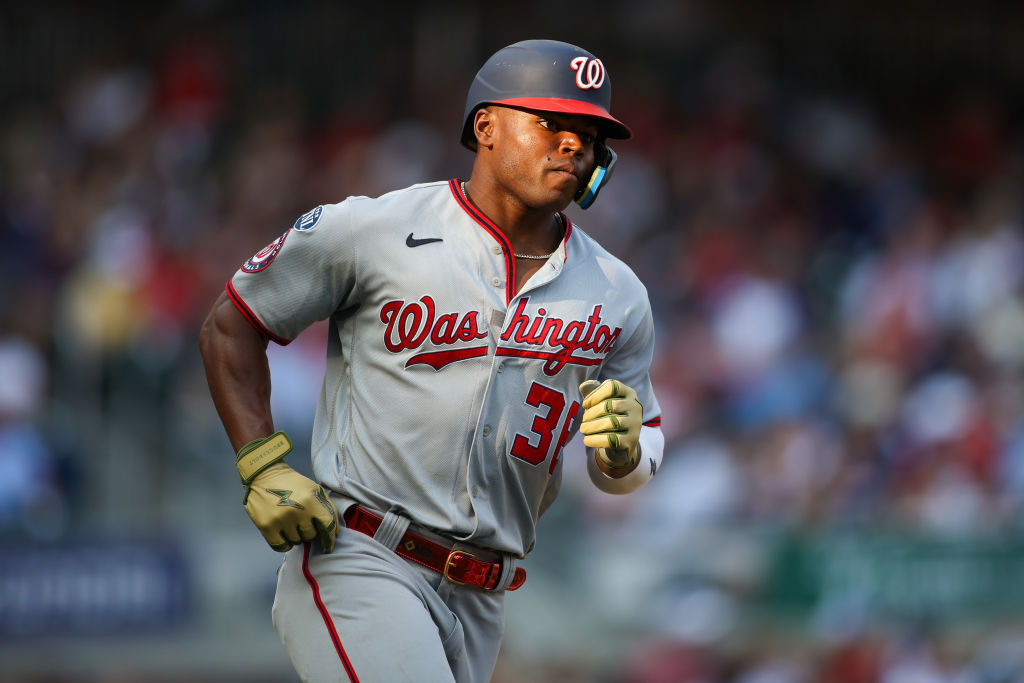PLAYER REVIEW: STONE GARRETT
Age on Opening Day 2024: 28
How acquired: Signed as free agent, November 2022
MLB service time: 1 year, 50 days
2023 salary: $720,000
Contract status: Under club control, arbitration-eligible in 2026, free agent in 2029
2023 stats: 89 G, 271 PA, 234 AB, 40 R, 63 H, 17 2B, 0 3B, 9 HR, 40 RBI, 3 SB, 1 CS, 26 BB, 82 SO, .269 AVG, .343 OBP, .457 SLG, .801 OPS, 120 OPS+, 5 DRS, 1.9 bWAR, 1.2 fWAR
Quotable: “He’s a guy that worked his way to get to the major leagues. I’m always partial to those guys, that put the work in, that worked really hard, to become who he is and really tries to get better. I challenged him early on to be a better outfielder; he’s done it. I challenged him to put the ball in play more; he’s done that. Drive in more runs. Everything I’ve asked him to do, he went out of his way to try to get it done. And I love guys like that.” – Davey Martinez
2023 analysis: When the Diamondbacks released Garrett in November, the Nationals swooped right in and him to a major league contract, believing the physically imposing outfielder could have a real future with them. Garrett, who arrived with a reputation for loud contact (but not enough regular contact), came to spring training competing with Alex Call and Derek Hill for the fourth outfielder’s spot on the Opening Day roster.
Outplayed by Call, Garrett was optioned to Triple-A in late March. But only three days into the season, he found himself in D.C., promoted to take the spot that opened up when Corey Dickerson strained his calf. Playing time was sporadic in the early going, with Martinez limiting the vast majority of his at-bats to opposing left-handers. But as he began to deliver with some regularity, and as the Nats struggled to get power production from most of their lineup, he began to find himself playing more.
Garrett’s breakthrough came in August. He entered the month with a .255/.333/.429 slash line in 211 plate appearances, then proceeded to slash a whopping .320/.379/.560 in 60 plate appearances and was included in the heart of the lineup on a near-daily basis. Until his season came to a sudden and heartbreaking halt.
Playing right field in the Nationals’ Aug. 23 game at Yankee Stadium, Garrett raced back to the wall and attempted a leaping catch of DJ LeMahieu’s opposite-field homer. He crashed to the ground in a heap and writhed in pain until trainers could reach him. Carted off the field several minutes later inside a hushed ballpark, Garrett later officially learned what had looked obvious to everyone all along: He fractured his left fibula and was out for the season.
2024 outlook: Garrett’s injury would’ve been heartbreaking no matter the context, but the fact it occurred just as he seemed to be coming into his own as a big league player added another layer of sadness to the situation. It also leaves him a gigantic question mark heading into next season.
The Nationals are hopeful he’ll be ready for spring training, but it may be too much to ask for him to be ready to be part of the Opening Day roster. An injury this severe doesn’t have a hard-and-fast timeline for rehab, and until he’s actually able to compete at full speed it will be tough to know when (or if) he’ll be able to recapture full playing form.
If he does make a full recovery, Garrett should figure into the Nats’ 2024 plans. He didn’t establish himself to the extent Lane Thomas did this season, but he showed enough to warrant a more extended look while the organization waits for its top-rated outfield prospects to reach the majors.
In his first year in D.C., Garrett did a lot to overcome the negative perceptions of his game. He actually wound up with a higher batting average vs. righties (.277) than lefties (.262), though he still slugged 106 points higher vs. lefties. He hit well to all fields, batting .414 to the opposite field, which helped him produce a nice .339 batting average with runners in scoring position. And he impressed in the field with both range and a strong arm.
A healthy Garrett still needs to trim his swing-and-miss rate a bit, especially against breaking balls (39.3 percent) and offspeed pitches (44.4 percent). But there’s certainly enough to like already about his game to want to see how he does on a semi-regular basis while the Nationals figure out who exactly fits into their long-term outfield arrangement.
By accepting you will be accessing a service provided by a third-party external to https://www.masnsports.com/





